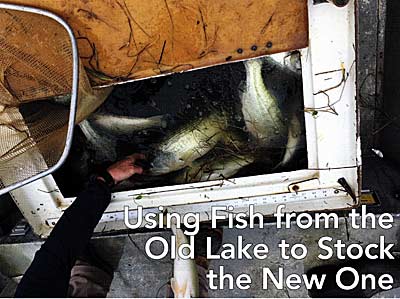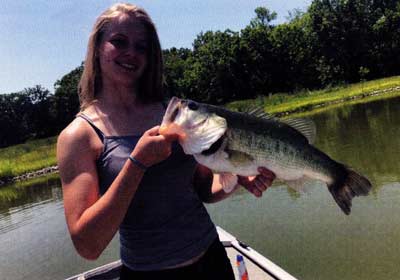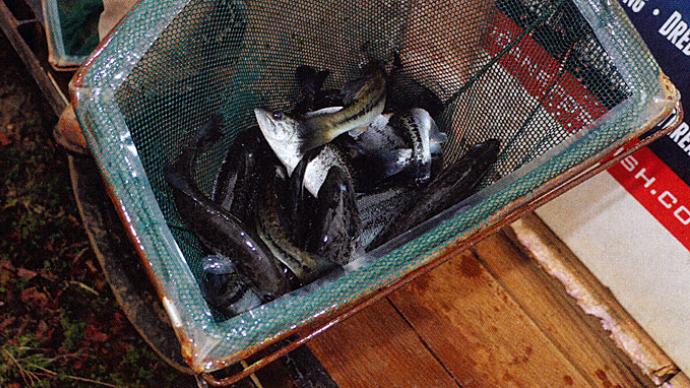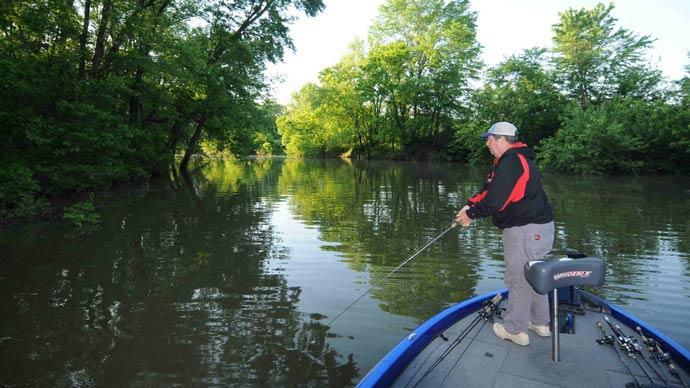
There's an 11-acre lake on hunting property not far from Belzoni, Mississippi in the Delta area famous for blues, barbecue, and catfish farms. Actually, not many years ago, Belzoni was promoted as the "Catfish Capital" of the United States. It probably still is. But, as goes commodity prices, so goes what farmers do. When catfish prices plummeted two decades or more ago, a good percentage of catfish acreage was put into CRP and now grows trees, grasses, and big deer; and it attracts more than its fair share of waterfowl in that section of the Central Fly way.
This private fishing lake sits purposefully perched slightly above natural ground level on flat ground north of Belzoni. Shaped like a pyramid with the top third shaved off, this four-sided lake sits amongst the twisting, turning flatlands of rich farmland. From maps, you can see how this terrain was formed over eons of river flow from muddy branches, which now also accept backwaters of the Yazoo River. Bordered by a backwater creek to the north and mature hardwoods to the south, the farm's eastern fields are more about crops and food plots. For more than a decade, this farm has been managed as a premier hunting resort, producing and attracting a variety of game species.
Some historical research and photos in the lodge showed just how productive this lake has been over its fairly short life. It was built in 2007 with scrapers and bulldozers, and designed so levees would surround the field and top out slightly above the flood plain. In order to gain depth and add shoreline, four peninsulas were built, jutting into the main body of the lake between 100 and 150 feet. It ended up being an aquaculture/ fish farm pond with a strong leaning toward a sport-fishing lake.
It was properly stocked, actively and thoughtfully managed, and all with the intent of growing some huge Largemouth bass. Within a few years, folks were catching fish on the cusp of honest-to-goodness bragging rights. By its sixth and seventh year, some true trophies were caught and released. But, that lake does what most highly productive lakes do, it became overcrowded. While it produced some giant bass, way up into double-digits, it also produced lots and lots of those cookie-cutter, carbon copy 12-15" bass.
A few years ago, a new owner emerged on the scene. He's an avid hunter of all types of game, but this lake was just as intriguing to him as the rest of the property. He had it surveyed by a consulting biologist who had worked on the lake before. The biologist explained that sometime around 2012 and running through 2015, a culling program was initiated. But it was hard to keep it up. Some lakes just grow lots and lots of bass. This is one of them. They harvested as many as 400 bass per year, but young bass always seemed to fill the slot.
A bigger problem manifested itself in 2015. With historic floods along the Mississippi River, water reached levels rarely seen, and water began backing up the tributaries. The Yazoo River meanders its way through more than 630,000 lower Mississippi Delta acres. That land flooded, and has seen more and more flooding since. I drove that stretch not long ago, and was startled at how many homes, barns, and rich delta farmland were inundated. This property sits at the top of that delta and the lake has been topped several times. Water just backs up and sits, waiting its turn to head toward the Gulf of Mexico. The first time it happened, farm staff put up a silt fence to block the exodus of fish from the lake. It seemed to work. After water receded, an electrofishing survey was done and the fishery seemed not too worse for the intrusion. Some nearby fish came in, but the lake didn't lose much of its primary population.
The new owner studied the property for months and then made some new decisions, as new owners do. The existing lodge was showing its age and maintenance needs. It sits on the north shore of this lake. He thought things through as he watched several more backwater floods come and go. While water rose and sat a foot over the top of his lake, a new vision for his lake and lodge rose in his mind. After plenty of due diligence, he decided to build both a lodge and a new lake to the east a couple thousand feet. He made that decision for several reasons. A new lodge made great sense, and it really should sit on the shores of a lake. So, a new lake was designed, as was a lodge.
While these decisions moved toward planning phases, he hired the fisheries biologist to come back and salvage as many good fish as he could from the existing lake. More than 300 bass were electrofished and moved to a smaller lake on a friends property less than an hour away. The goal was to save the fish and then bring them back and stock them into the new lake.

By now, the owner had put together a strong team of guys who were heavy into planning. One of them has been the key property caretaker for years, working for the prior owner as well.
Meanwhile, the recipient of the harvested bass threw some dollars into the fish
to make sure they are well-fed. He's grown to appreciate the high catch rates and a few really nice fish. Come to find out, of those 300 fish harvested, most were in the 2-3-pound size range, with some in the 4-6-pound size classes and a handful of true trophies, exceeding 8 pounds.
So, here's the dilemma. Should the new owner retrieve those bass and bring them back, and stock them into his brand-new lake?
What would you do?
He's willing to fill the lake with big numbers of forage fish. He's willing to bolster that food chain with regular stockings of forage fish from bluegills to threadfin shad and crawfish. All those fish are abundant from hatchery sources in that part of the nation.
When those adult bass were captured and moved from the lake where they grew up and were transplanted into another lake, the dynamics were dramatic. There were existing fish, from bass to sunfish. Adding 300 hungry mouths, probably totaling beyond 500 pounds, into a small lake, you can imagine the demand for food and space. Of those 300 fish, likely 30% of them will thoroughly adjust to their new settings. Another 20-30% will adjust to above average expectations. The rest will stay the same or deteriorate.
So, are we saying that when it's time, go get that top 30-40% and move them to the new lake? Not at all. It's likely the same thing would happen, moving from where they are now to a brand-new lake. 30% would adjust and thrive, some would be above average and the rest would not be the kinds of fish to build this new lake's fishery as the new owner wants it.
While it can still be argued that the best of the best could grow to huge sizes, and do it quickly, it can be just as easily argued that they might not.
Remember the statement above about the lake reaching its peak, starting around 2013? Some trophy bass were really growing, but there was a bottleneck of 12-14" fish for several years, even though culling helped. Those biggest fish from 2012-13 were the top 30% of the originally stocked fish, and they were all females. While those fish grew as big as they could, they reproduced along the way—starting about Year 3. By Years 4 and 5 (2011-2012), baby bass were climbing the ladder into the 12-14" slot. Those originally stocked bass are now at the end of their 12-14-year life span.
What about those bass in the 3-6-pound range? We have to ask how old they are. If those fish are four or five years old or older, their growth potential is not strong. Then, when they're moved into a new environment, only a percentage of those will make the transition.
The new lake will soon be finished and crucial stocking decisions will be made. One key component is building the food chain. Since we all know that it takes ten pounds of baitfish for a bass to gain a pound, to stock it with adult bass transferred from another lake means starting the lake with enough baitfish to support the bass long term, or give it some time for the food chain to develop and then stock the bass.
These are all some pretty big obstacles to meeting the intended goal. If the new owner wants some trophy bass fast, bring the fish back. Those trophies will last maybe two to four years before their babies start coming up the chain with somewhat unpredictable results.
My advice?
Don't do it. We don't know the age of the bass that were transferred in the first place. When they were moved, they had to adjust to the new environment. In the new lake, they'll have to adjust again. A significant number just won't make that transition. An immediate management concern is tracking each of the bass over the next two to four years, and then deciding whether to leave them in or take them out. The new owner would need to write a big check to supply an adequate food chain to support these bass as they make the transition. Yes, he'd have immediate fishing, but what's that worth? Then, biologically, he loses the numbers game because those 10-20 bass per acre are missing a key part of the puzzle. There are no mid-sized fish to help eat young of the year bass. That means big numbers of slot fish will start showing up, as they are weeding out the under-performers that just won't make the next transition. That's a lot of work and dollars to preserve the best-of-the-best for only the few years they have left.
For the goal of having a long-term, trophy bass lake, start fresh. Start with young fish that can grow up and adjust to that environment, allowing the food chain to develop at a rapid pace. In this case, starting with young fish makes the most sense. Those new, young babies have the best shot at reaching their maximum growth potential. With good management, which they'll have, they'll take this new lake and extend its life as a trophy lake well into its teen years.
Reprinted with permission from Pond Boss Magazine



